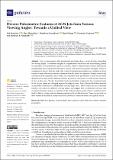Diverse Polarimetric Features of AGN Jets from Various Viewing Angles: Towards a Unified View
Author(s)
Tsunetoe, Yuh; Mineshige, Shin; Kawashima, Tomohisa; Ohsuga, Ken; Akiyama, Kazunori; Takahashi, Hiroyuki R.; ... Show more Show less
Downloadgalaxies-10-00103.pdf (2.645Mb)
Publisher with Creative Commons License
Publisher with Creative Commons License
Creative Commons Attribution
Terms of use
Metadata
Show full item recordAbstract
Here, we demonstrate that polarization properties show a wide diversity depending on viewing angles. To simulate images of a supermassive black hole and surrounding plasma, we performed a full-polarimetric general relativistic radiative transfer based on three-dimensional general relativistic magnetohydrodynamics models with moderate magnetic strengths. Under an assumption of a hot-jet and cold-disk in the electron temperature prescription, we confirmed a typical scenario where polarized synchrotron emissions from the funnel jet experience Faraday rotation and conversion in the equatorial disk. Further, we found that linear polarization vectors are inevitably depolarized for edge-on-like observers, whereas a portion of vectors survive and reach the observers in face-on-like cases. We also found that circular polarization components have persistent signs in the face-on cases, and changing signs in the edge-on cases. It is confirmed that these features are smoothly connected via intermediate viewing-angle cases. These results are due to Faraday rotation/conversion for different viewing angles, and suggest that a combination of linear and circular polarimetry can give a constraint on the inclination between the observer and black hole’s (and/or disk’s) rotating-axis and plasma properties in the jet–disk structure. These can also lead to a more statistical and unified interpretation for a diversity of emissions from active galactic nuclei.
Date issued
2022-10-21Department
Haystack ObservatoryPublisher
Multidisciplinary Digital Publishing Institute
Citation
Galaxies 10 (5): 103 (2022)
Version: Final published version